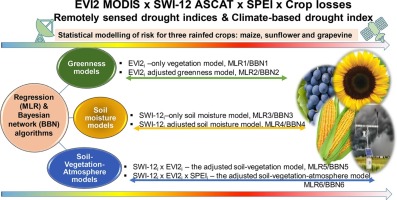当前位置:
X-MOL 学术
›
Agric. Water Manag.
›
论文详情
Our official English website, www.x-mol.net, welcomes your
feedback! (Note: you will need to create a separate account there.)
Statistical modelling of drought-related yield losses using soil moisture-vegetation remote sensing and multiscalar indices in the south-eastern Europe
Agricultural Water Management ( IF 5.9 ) Pub Date : 2020-06-01 , DOI: 10.1016/j.agwat.2020.106168 Vera Potopová , Miroslav Trnka , Pavel Hamouz , Josef Soukup , Tudor Castraveț
Agricultural Water Management ( IF 5.9 ) Pub Date : 2020-06-01 , DOI: 10.1016/j.agwat.2020.106168 Vera Potopová , Miroslav Trnka , Pavel Hamouz , Josef Soukup , Tudor Castraveț

|
Abstract Meteorological and agricultural information coupled with remote sensing observations has been used to assess the effectiveness of satellite-derived indices in yield estimations. The estimate yield models generated by both the regression (MLR) and Bayesian network (BBN) algorithms and their levels of predictive skill were assessed. The enhanced vegetation index (EVI2), soil water index (SWI), standardized precipitation evaporation index (SPEI) have been considered predictors for three rainfed crops (maize, sunflower and grapevine) grown in 37 districts in the Republic of Moldova (RM). We used the weekly EVI2, which was collected by MODIS instruments aboard the Terra satellite with a 250m × 250m spatial resolution and aggregated for each district during the 2000–2018 period. We also used the weekly SWI, which was collected from the ASCAT instruments with a 12 km x 12 km spatial resolution and aggregated for each district at the topsoil (0–40 cm; SWI-12) and the root-zone layer (0–100 cm; SWI-14) during 2000–2018. The multiscalar SPEI during 1951–2018 farming years proved to be a significant addition to the remote sensing indices and led to the development of a model that improved the yield assessment. The study also summarized (i) the optimal time window of satellite-derived SWIi and EVI2i for yield estimation, and (ii) the capability of remotely sensed indices for representing the spatio–temporal variations of agricultural droughts. We developed statistical soil-vegetation-atmosphere models to explore drought-related yield losses. The skill scores of the sunflower MLR and BBN models were higher than those for the maize and grape models and were able to estimate yields with reasonable accuracy and predictive power. The accurate estimation of maize, sunflower and grapevine yields was observed two months before the harvest (RMSE of ∼1.2 tha-1). Despite the fact that summer crops (maize, sunflower) are able to develop a root system that uses the entire root zone depth, however, the SWI-12 had the stronger correlation with crop yield, then SWI-14. This explains much better the fit between yields of the crops and SWI-12, which represents soil moisture anomaly in the key rooting layer of soil. In any case, all summer crops showed negative correlations with each of the remote sensing soil moisture indices in the early and middle of the growing season, with SWI-12 performing better than SWI-14. Based on the crop-specific soil moisture model, we found that topsoil moisture declines in the most drought-susceptible crop growth stages, which indicates that RM is a good candidate for studying drought persists as main driver of rainfed yield losses in the south-eastern Europe.
中文翻译:

利用东南欧土壤水分-植被遥感和多标量指数对与干旱相关的产量损失进行统计建模
摘要 气象和农业信息与遥感观测相结合已被用于评估卫星衍生指数在产量估算中的有效性。评估了由回归 (MLR) 和贝叶斯网络 (BBN) 算法生成的估计产量模型及其预测技能水平。增强型植被指数 (EVI2)、土壤水分指数 (SWI)、标准化降水蒸发指数 (SPEI) 被认为是摩尔多瓦共和国 (RM) 37 个地区种植的三种雨育作物(玉米、向日葵和葡萄藤)的预测指标。我们使用了每周一次的 EVI2,它由 Terra 卫星上的 MODIS 仪器收集,空间分辨率为 250m × 250m,并在 2000-2018 年期间为每个地区汇总。我们还使用了每周的 SWI,从具有 12 公里 x 12 公里空间分辨率的 ASCAT 仪器中收集,并在表土(0-40 厘米;SWI-12)和根区层(0-100 厘米;SWI-14)的每个区域聚合2000-2018 年期间。1951-2018 耕作年间的多标量 SPEI 被证明是对遥感指数的重要补充,并导致了改进产量评估的模型的开发。该研究还总结了 (i) 卫星衍生的 SWIi 和 EVI2i 用于产量估计的最佳时间窗口,以及 (ii) 遥感指数代表农业干旱时空变化的能力。我们开发了统计土壤-植被-大气模型来探索与干旱相关的产量损失。向日葵 MLR 和 BBN 模型的技能分数高于玉米和葡萄模型的技能分数,并且能够以合理的准确性和预测能力估算产量。在收获前两个月观察到对玉米、向日葵和葡萄藤产量的准确估计(RMSE 约为 1.2 tha-1)。尽管夏季作物(玉米、向日葵)能够开发使用整个根区深度的根系,但是,SWI-12 与作物产量的相关性更强,然后是 SWI-14。这更好地解释了作物产量与 SWI-12 之间的拟合,SWI-12 代表土壤关键根层中的土壤水分异常。在任何情况下,所有夏季作物在生长季节的早期和中期都与每个遥感土壤水分指数呈负相关,SWI-12 的性能优于 SWI-14。基于特定作物的土壤水分模型,我们发现表土水分在最易受干旱影响的作物生长阶段下降,这表明 RM 是研究干旱持续作为东南部雨育产量损失的主要驱动因素的良好候选者。欧洲。
更新日期:2020-06-01
中文翻译:

利用东南欧土壤水分-植被遥感和多标量指数对与干旱相关的产量损失进行统计建模
摘要 气象和农业信息与遥感观测相结合已被用于评估卫星衍生指数在产量估算中的有效性。评估了由回归 (MLR) 和贝叶斯网络 (BBN) 算法生成的估计产量模型及其预测技能水平。增强型植被指数 (EVI2)、土壤水分指数 (SWI)、标准化降水蒸发指数 (SPEI) 被认为是摩尔多瓦共和国 (RM) 37 个地区种植的三种雨育作物(玉米、向日葵和葡萄藤)的预测指标。我们使用了每周一次的 EVI2,它由 Terra 卫星上的 MODIS 仪器收集,空间分辨率为 250m × 250m,并在 2000-2018 年期间为每个地区汇总。我们还使用了每周的 SWI,从具有 12 公里 x 12 公里空间分辨率的 ASCAT 仪器中收集,并在表土(0-40 厘米;SWI-12)和根区层(0-100 厘米;SWI-14)的每个区域聚合2000-2018 年期间。1951-2018 耕作年间的多标量 SPEI 被证明是对遥感指数的重要补充,并导致了改进产量评估的模型的开发。该研究还总结了 (i) 卫星衍生的 SWIi 和 EVI2i 用于产量估计的最佳时间窗口,以及 (ii) 遥感指数代表农业干旱时空变化的能力。我们开发了统计土壤-植被-大气模型来探索与干旱相关的产量损失。向日葵 MLR 和 BBN 模型的技能分数高于玉米和葡萄模型的技能分数,并且能够以合理的准确性和预测能力估算产量。在收获前两个月观察到对玉米、向日葵和葡萄藤产量的准确估计(RMSE 约为 1.2 tha-1)。尽管夏季作物(玉米、向日葵)能够开发使用整个根区深度的根系,但是,SWI-12 与作物产量的相关性更强,然后是 SWI-14。这更好地解释了作物产量与 SWI-12 之间的拟合,SWI-12 代表土壤关键根层中的土壤水分异常。在任何情况下,所有夏季作物在生长季节的早期和中期都与每个遥感土壤水分指数呈负相关,SWI-12 的性能优于 SWI-14。基于特定作物的土壤水分模型,我们发现表土水分在最易受干旱影响的作物生长阶段下降,这表明 RM 是研究干旱持续作为东南部雨育产量损失的主要驱动因素的良好候选者。欧洲。











































 京公网安备 11010802027423号
京公网安备 11010802027423号